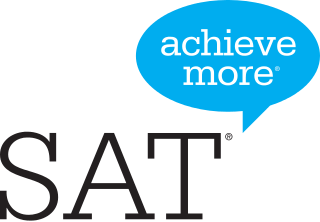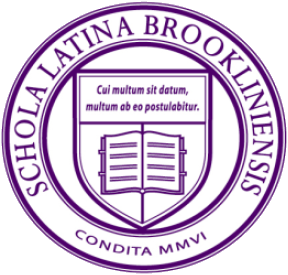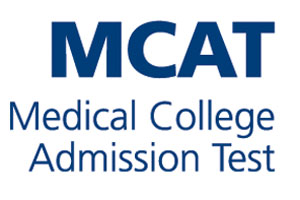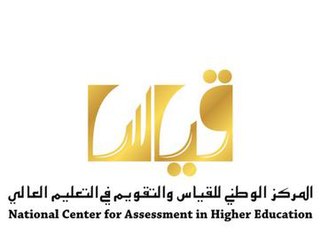
The ACT is a standardized test used for college admissions in the United States. It is currently administered by ACT, a nonprofit organization of the same name. The ACT test covers four academic skill areas: English, mathematics, reading, and scientific reasoning. It also offers an optional direct writing test. It is accepted by all four-year colleges and universities in the United States as well as more than 225 universities outside of the U.S.

The SAT is a standardized test widely used for college admissions in the United States. Since its debut in 1926, its name and scoring have changed several times; originally called the Scholastic Aptitude Test, it was later called the Scholastic Assessment Test, then the SAT I: Reasoning Test, then the SAT Reasoning Test, then simply the SAT.

The Graduate Management Admission Test is a computer adaptive test (CAT) intended to assess certain analytical, writing, quantitative, verbal, and reading skills in written English for use in admission to a graduate management program, such as an MBA program. It requires knowledge of certain specific grammar and knowledge of certain specific algebra, geometry, and arithmetic. According to the test-owning company, the Graduate Management Admission Council (GMAC), the GMAT assesses analytical writing and problem-solving abilities while also addressing data sufficiency, logic, and critical reasoning skills that it believes to be vital to real-world business and management success. It can be taken up to five times a year but no more than eight times total. Attempts must be at least 16 days apart.
In science education, a word problem is a mathematical exercise where significant background information on the problem is presented in ordinary language rather than in mathematical notation. As most word problems involve a narrative of some sort, they are sometimes referred to as story problems and may vary in the amount of technical language used.
The eleven-plus (11+) is a standardized examination administered to some students in England and Northern Ireland in their last year of primary education, which governs admission to grammar schools and other secondary schools which use academic selection. The name derives from the age group for secondary entry: 11–12 years.
The Graduate Record Examinations (GRE) is a standardized test that is an admissions requirement for many graduate schools in the United States and Canada and a few other countries. The GRE is owned and administered by Educational Testing Service (ETS). The test was established in 1936 by the Carnegie Foundation for the Advancement of Teaching.
The High School Proficiency Assessment was a standardized test that was administered by the New Jersey Department of Education to all New Jersey public high school students in March of their junior year until 2014-2015 when it was replaced by the PARCC. Together with the New Jersey Assessment of Skills and Knowledge, which was administered in grades 3-8, the HSPA was part of a battery of tests used to assess student performance in New Jersey's public schools.
Cognitive tests are assessments of the cognitive capabilities of humans and other animals. Tests administered to humans include various forms of IQ tests; those administered to animals include the mirror test and the T maze test. Such study is important to research concerning the philosophy of mind and psychology, as well as determination of human and animal intelligence.
Alan S. Kaufman is an American psychologist and writer known for his work on intelligence testing.
The Independent School Entrance ExaminationISEE online page (ISEE) is an entrance exam used by many independent schools and magnet schools in the United States. Developed and administered by the Educational Records Bureau, the ISEE has four levels: the Primary level, for entrance to grades 2–4; Lower level, for entrance in grades 5–6; Middle level, for entrance in grades 7–8; Upper level, for entrance in grades 9–12. All levels consist of five sections: Verbal Reasoning, Quantitative Reasoning, Reading Comprehension, Mathematics Achievement, and a 30-minute essay. The ISEE can be seen as a parallel to the Secondary School Admission Test, or SSAT. It is currently administered by Measurement Incorporated.
The Secondary School Admission Test (SSAT) is an admission test administered by The Enrollment Management Association in the United States to students in grades 3–11 to provide a standardized measure that will help professionals in independent or private elementary, middle, and high schools to make decisions regarding student test taking.
The Dental Admission Test is a multiple-choice standardized exam taken by potential dental school students in the United States and Canada. The DAT is a computer based test that can be administered almost any day of the year. Tests are taken at Prometric testing centers throughout the United States after the preliminary application through the American Dental Association is completed. Each applicant may only take the test a total of three times before having to ask special permission to take the exam again. After taking the exam, applicants must wait 90 days before repeating it. Each exam costs $495, all of which is non-refundable.

The Brooklyn Latin School is a public specialized high school in New York City. It opened in September 2006. The ideals governing Brooklyn Latin are borrowed largely from the Boston Latin School, and popular society's ideals. The school’s founding headmaster was Jason Griffiths.
The University Clinical Aptitude Test (UCAT) is an admissions test used in the selection process by a consortium of universities in the United Kingdom, Australia and New Zealand for their medical and dental degree programmes. Launched in 2006 as the UK Clinical Aptitude Test (UKCAT), it was renamed in 2019 following the launch of the test in Australia and New Zealand.
The Psychometric Entrance Test (PET) – commonly known in Hebrew as "ha-Psikhometri" – is a standardized test that serves as an entrance exam for institutions of higher education in Israel. The PET covers three areas: quantitative reasoning, verbal reasoning and English language. It is administered by the National Institute for Testing and Evaluation (NITE) and plays a considerable role in the admissions process. A score combining students' performance on the PET with the average score of their high school matriculation tests has been found to be a highly predictive indicator of students' academic performance in their first year of higher education.

The ICFESexamination, or Saber 11, is a high school exit examination administered annually in grade 11 in Colombian high schools. The exam is standardized, similar to the SAT and ACT examinations taken by high school students in the United States. The purpose of the exam is to evaluate students' aptitude in five subjects: critical reading, mathematics, social studies, science, and English. Each exam question has four multiple-choice answers, except for the English section which provides between three and eight possible answers for each question.

The Medical College Admission Test is a computer-based standardized examination for prospective medical students in the United States, Australia, Canada, and Caribbean Islands. It is designed to assess problem solving, critical thinking, written analysis and knowledge of scientific concepts and principles. Before 2007, the exam was a paper-and-pencil test; since 2007, all administrations of the exam have been computer-based.

Measurement is derived from the verb 'to measure' which means to assess something; in Arabic 'yaqees' 'measure' has the meaning of comparing something to something else. In this sense, measurement is a daily practice that manifests itself in all our assessment activities, whether we assess concrete things in terms of size and color, or abstract things such as human relations. The ultimate goal of 'measuring' something is to assess ourselves in comparison to everything else in the world.
The Cooperative Admissions Examination Program, or COOP exam, is a standardized admissions test used by many Catholic High schools in the Northern New Jersey and Hudson Valley region.
The SAT is a standardized test commonly used for the purpose of admission to colleges and universities in the United States. The test, owned by the College Board and originally developed by Carl Brigham, was first administered on June 23, 1926, to about 8,000 students. The test was introduced as a supplement to the College Board essay exams already in use for college admissions, but ease of administration of the SAT and other factors led to the discontinuation of the essay exams during World War II. The SAT has since gone through numerous changes in content, duration, scoring, and name; the test was taken by more than 1.5 million students in the graduating high school class of 2021.